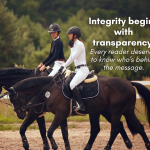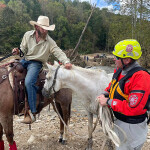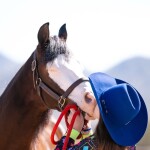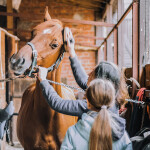When a horse becomes lame or has an injury it can be a challenging time for horse owners. Rehabilitating injured horses can sometimes be a long, difficult & frustrating process. Depending on the type of injury it can restrict turnout, forcing more time in a stall or a confined area, and significantly reduce movement & exercise for the horse. This all affects the horse’s mental & physical state.
Assessing acute-onset lameness is essential and can help a horse recover sooner than later. According to American Association of Equine Practitioners (AAEP), “Experienced riders may detect minor alterations in a gait before they are apparent to an observer. Lameness may appear as a subtle shortening of the stride, or the condition may be so severe that the horse will not bear weight on the affected limb.”
With such extremes of lameness possible, a lameness grading system has been developed by the AAEP to aid both communication and record-keeping. The scale ranges from zero to five, with zero being no perceptible lameness, and five being most extreme. The AAEP’s grading system is shown in Image A displayed above.
As an owner and rider, it is important to assess the level of lameness a horse is experiencing to better communicate with your veterinarian. Some of the best things to do according to Kyla Szemplinski, MS with UT-TSU Extension Office is to “call your veterinarian immediately, especially for ALL life-threatening injuries. This includes uncontrollable bleeding, elevated temperatures, puncture wounds, signs of colic, eye injuries, difficulty breathing, suspected fractures or other soft tissue injuries.
It is always beneficial to have multiple veterinarians at your disposal in case your usual veterinarian is unavailable to come. And get the horse to a safe, calm and clean environment. Limit movement if possible.” Kyla recommends checking your horse’s vital signs as well. Vital Signs are referenced in Image B below.
Dr. Megan Hunt, DVM, owner of Cornerstone Equine Veterinary Services states, “timely care is critical to have a good outcome. We don’t want to be overly aggressive and overtreat; however, sometimes it matters to treat immediately; 24 to 48 hours can make a big impact on overall recovery.”
She too recommends owners assess their horse’s level of lameness and call their veterinarian immediately, especially if the horse is non-weight bearing, if there is any blood, puncture woods, and swelling. These make it an emergency. “Try to always remember to stay calm. It is important to stay calm in the situation so you do not add to your horse’s own stress or nervousness,” Dr. Hunt advises.
After assessing your horse’s level of lameness and talking with your veterinarian focus on keeping your horse calm and continue to check vitals and physical signs of distress and pain such as: sweating, lack of appetite, lying down more than usual, unusual posture or stance, non-weight bearing on a limb or teeth grinding.
Addressing the level of pain is something your veterinarian will do as soon as they arrive and start their physical exam. Your veterinarian will examine the horse’s medical history (past and present difficulties with the horse, previous injuries, and current exercise and turn out routines), he or she will do a visual appraisal of the horse at rest, conduct a hands-on and thorough physical examination, test hooves with hoof testers, evaluate the horse in motion, and do joint flexion tests if needed.
Depending on the results from the physical examination, diagnostic tests may include noninvasive or invasive tests such as: nerve or joint blocks, radiographs, scintigraphy (nuclear scanning). Radioisotopes injected intravenously into the horse are concentrated in areas of injury, ultrasounds, arthroscopy (a surgical procedure that allows visual examination of the inside of a joint or tendon sheath,) Blood, synovial (joint) fluid and tissue samples. These samples can be examined for infection or inflammation.
The Recovery and Outcome
Once your veterinarian has identified and diagnosed the cause of lameness or injury he or she will then create a recovery and physical therapy plan. The length of recovery and rehabilitation will depend on the severity of the injury. This might be a multi-tiered process, meaning, the outcome of recovery may not be 100% certain until inflammation decreases and the healing process progresses.
“Be patient and trust the rehab process. I don’t want my clients’ horses to be on stall rest,” Dr. Hunt states. She discusses how specific treatment plans are important for horses’ specific injury, and how she likes to look at the whole body of the horse, not just the specific injury. “How is the horse’s muscle mass doing? How is his coat, is he showing signs of potential ulcers from stress? Is he gaining weight or losing weight? We want the specific injury to get better, but there are so many things we can do to support the horse’s whole body through therapies such as acupuncture, adjustments, PEMF, appropriate nutrition, and exercises and stretches, like yoga for horses, and ground pole work. These things help support the horse’s whole body and can keep the horse from becoming bored. Also, don’t be afraid to discuss calming medications with your veterinarian. These medications can help prevent the horse from further injury and can help keep the owner safe during the process too,” Dr. Hunt recommends.
Alexandra Boulez, a mid-south equestrian and horse owner, found herself rehabbing her 12-year-old Thoroughbred, Felix, due to a fractured splint bone in his back right leg. He sustained the injury from being kicked by another horse in the pasture. At the time of the injury her team of veterinarians were unsure if he was going to be able to return to his previous level of exercise. Felix was on stall rest for six months. He slowly returned to regular turnout over a two month transition period, and Alexandra says, “I didn’t feel he was mentally or physically ready to go back to “training” per se until about eight to eight and a half months post injury.”
Even though the healing process has been slow and uncertain at times, Felix is now back in training to build strength and stamina after having almost a full year off due to his fracture.
“I think one of the most important things is to be realistic as an owner about what you can and can’t do, and what your barn can and can’t do. Do you have the time to do a lot of the rehab yourself (wrapping, icing, hand walking, etc)? Is your current barn capable of doing rehab, or do you need a barn capable of taking on the extra work associated with rehab? These are all important things to consider for successful rehabbing.”
Alexandra continues, “do not over analyze a bad day or a bad couple of days. Whether that be soundness or mentally. I found it helpful to not analyze soundness any more frequently than once a month. Otherwise, you can find yourself not seeing improvement when you analyze too often.”
The best thing an owner and rider can do when faced with an uncertain outcome of an injury is to stay optimistic and approach the injury as something every equestrian will face with a horse at some point in time. Being your horse’s advocate and using the rehab time as human/ horse bonding time can help strengthen your relationship with your horse. Overall, the top priority and focus should be managing your horse’s complete physical and mental health during rehab.
Lean on your horse family too. If your horse’s injury will keep you out of the saddle for a long period of time, talk with your trainer about riding a lesson horse, or helping with exercise rides to keep you in riding shape. You may have a friend who needs their horse exercised more than they are able to do, so be open to riding other horses, and working on your own riding while your horse recovers.
Remember to always assess slight changes in your horse’s way of going or movement. And be knowledgeable about small signs of a potential problem that may lead to bigger issues if they go unaddressed. The last piece of advice is to have a strong relationship with your team of veterinarians and to always be patient with them, and trust them. Be respectful of their time, do as they recommend, and ask them to communicate with you in a way that you are able to process and fully understand their diagnostic findings for the best outcome for your horse.









